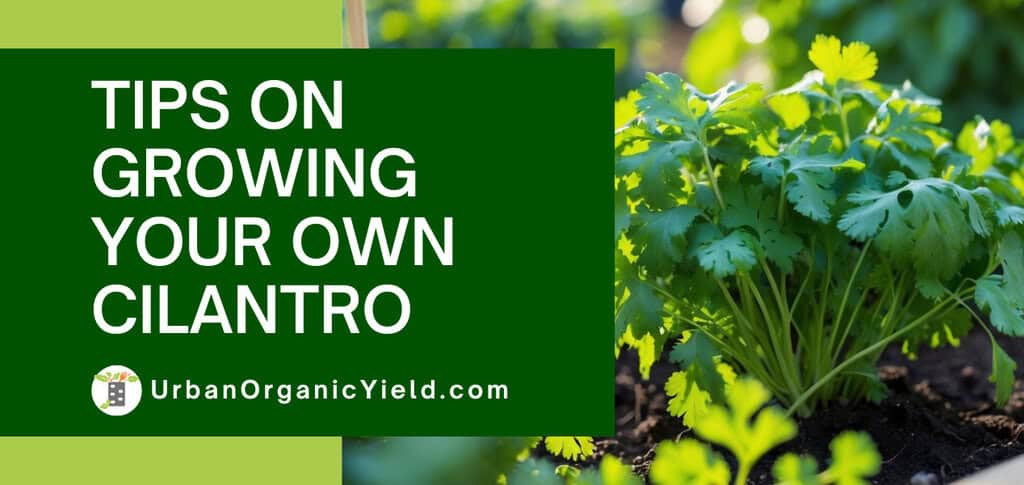Table of Contents
Key Takeaways
- Soil: Use loose, well-draining soil with a pH of 6.2–6.8
- Varieties: Choose slow-bolting types like Slow Bolt or Calypso for better heat tolerance.
- Seeds: Always plant fresh seeds and soak them before sowing to improve germination. Sow seeds directly about 6 inches apart and keep soil moist but not soggy.
- Containers: Use pots at least 8 inches deep with drainage holes for container growing.
- Watering & Thinning: Water when the top inch of soil is dry; thin seedlings to 6 inches apart.
- Fertilizing & Bolting: Fertilize lightly and pinch off flower buds to delay bolting.
- Harvesting: Pick outer leaves regularly, never more than a third at a time.
- Companion Planting: Avoid planting near fennel, tall shade plants, and aggressive herbs like mint.

Cilantro can be hard to grow, but if you know the basics, it’s not too hard. I’ve tried a few things and discovered what works best.
Getting the soil right is Key
Cilantro doesn’t like wet soil. I usually choose soil that is loose and drains nicely and has a pH between 6.2 and 6.8.
I check the soil pH and add lime or sulfur if necessary. Adding compost or old manure makes the soil more fertile, but new manure is a no-no. I learnt this the hard way!
Finally make sure there is drainage. Cilantro will not grow well in soggy soil.
Picking Seeds and Different Types of Cilantro
If you want to prevent early bolting, choose the proper kind of cilantro is quite helpful. I use slow-bolting kinds like “Slow Bolt” and “Calypso” for hot weather since they remain leafy longer and can endure the heat better.
Bolting means premature blooming (or flowering) of a plant, usually vegetables or herbs, when they shoot up a flower stalk and begin to produce seeds before it's time for harvesting.
If you want something that grows quickly and tastes delicious, “Santo” is a fantastic choice. “Leisure” is a classic that you can always find.
Each year, use new seeds since old ones don’t always sprout properly. I also prefer to soak the seed husks for a day or two before planting them. This helps them sprout faster.
I recommend trying different kinds since they may taste differently. Also, certain kinds are preferable if you want to save coriander seeds for following year.
How to Plant Cilantro Plants
I plant seeds just where they will grow, approximately six inches apart, then cover them with a little bit of dirt.
I plant a few weeks before the last frost in the spring and again 8–10 weeks before it gets cold in the Fall. To keep seeds from rotting, it’s necessary to keep the soil moist but not too wet.
As for companion planting cilantro, I say make it easy on yourself and plant it in a container by itself.

What I use for containers
I always select containers for pots that are at least eight inches deep and have drainage holes. You may use ceramic, plastic, wood, or window boxes. I put them indoors near a window that gets at least four hours of daylight.
Thinning and Watering
When the top inch of soil feels dry, I water it, but I always do it at the base to prevent illness from spreading.
I trim the seedlings to six inches apart after they are a few inches tall, preserving the strongest ones.
In the summer, give them some shade. As soon as flower buds form, pinch them off.
Too Much Fertilizer Causes Bolting Cilantro
I use very little fertilizer because too much fertilizer will be too much nitrogen for cilantro; it’ll cause it to bolt and taste bad.
Key is to regularly harvest as it helps plants stay productive for longer.
How to Handle Pests
A lot of the time, aphids and spider mites appear. I use neem oil and insecticidal soap to get rid of spider mites, but I only use it early morning or late evening. I also cultivate flowers to draw in helpful creatures like lacewings and ladybugs.
Picking and Keeping Cilantro
When the plants are about four inches tall, I start harvesting them. I take off the outer leaves first and never more than a third at a time.
When you put fresh cilantro in the fridge with water, it will stay fresh for approximately a week. I wrap leaves in moist paper towels or freeze them in ice cube trays to keep them longer.
FAQ
References
Lindsey Hyland grew up in Arizona where she studied at the University of Arizona’s Controlled Environment Agriculture Center. She continued her gardening education by working on organic farms in both rural and urban settings. She started UrbanOrganicYield.com to share gardening tips and tactics. She’s happy to talk about succulents and houseplants or vegetables and herbs – or just about anything in a backyard garden or hydroponics garden.

